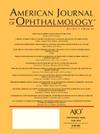中心性浆液性脉络膜视网膜病变扁平不规则色素上皮脱离的脉络膜层分析。
IF 4.1
1区 医学
Q1 OPHTHALMOLOGY
引用次数: 0
摘要
目的比较无并发症慢性中央浆液性脉络膜视网膜病变(uCSC)和慢性脉络膜视网膜病变合并1型黄斑新生血管(cCSC)的扁平不规则色素上皮脱离(PEDs)下脉络膜层厚度。设计:回顾性横断面研究方法:本回顾性研究包括94只treatment-naïve眼(45只uCSC, 49只cCSC)的扁平不规则儿科。利用扫描源光学相干层析成像(SS-OCT),我们测量了PEDs下的绒毛膜- sattler层复厚度(SLCCT)和Haller层厚度(HLT)。测量在每个PED下的三个相等分区的中心段进行。结果cCSC的SLCCT均值显著低于uCSC(47.2±18.6 μm vs 81.4±22.4 μm, p = 0.002)。同样,cCSC的HLT降低(265.3±45.8 μm vs 334.5±43.2 μm, p = 0.008)。其他特征包括年龄(56.1±7.9 vs 54.3±8.4岁,p = 0.28)、病程(11.2±3.1 vs 8.4±2.6个月,p = 0.08)和PED维度在两组间具有可比性。结论scsc眼与uCSC眼相比,在扁平不规则的PEDs下,scsc眼的绒毛膜- sattler复合物和Haller’s层均明显变薄。这些发现表明,渐进性脉络膜变薄可能是新血管转化的一个关键特征,可以作为一种潜在的生物标志物来识别有新血管并发症风险的眼睛。本文章由计算机程序翻译,如有差异,请以英文原文为准。
Choroidal Layer Analysis Under Flat Irregular Pigment Epithelial Detachments in Central Serous Chorioretinopathy.
PURPOSE
To compare choroidal layer thickness beneath flat irregular pigment epithelial detachments (PEDs) between uncomplicated chronic central serous chorioretinopathy (uCSC) and CSC complicated by type 1 macular neovascularization (cCSC).
DESIGN
Retrospective cross-sectional study METHODS: This retrospective study included 94 treatment-naïve eyes (45 uCSC, 49 cCSC) with flat irregular PEDs. Using swept-source optical coherence tomography (SS-OCT), we measured choriocapillaris-Sattler layer complex thickness (SLCCT) and Haller's layer thickness (HLT) beneath the PEDs. Measurements were performed in the central segments of three equal divisions under each PED.
RESULTS
Mean SLCCT was significantly lower in cCSC compared to uCSC (47.2 ± 18.6 μm vs 81.4 ± 22.4 μm, p = 0.002). Similarly, HLT was reduced in cCSC (265.3 ± 45.8 μm vs 334.5 ± 43.2 μm, p = 0.008). Other characteristics, including age (56.1 ± 7.9 vs 54.3 ± 8.4 years, p = 0.28), disease duration (11.2 ± 3.1 vs 8.4 ± 2.6 months, p = 0.08), and PED dimensions were comparable between groups.
CONCLUSIONS
cCSC eyes show significant thinning of both the choriocapillaris-Sattler complex and Haller's layer under flat irregular PEDs compared to uCSC eyes. These findings suggest that progressive choroidal thinning may be a key feature of neovascular transformation and could serve as a potential biomarker to identify eyes at risk for neovascular complications.
求助全文
通过发布文献求助,成功后即可免费获取论文全文。
去求助
来源期刊
CiteScore
9.20
自引率
7.10%
发文量
406
审稿时长
36 days
期刊介绍:
The American Journal of Ophthalmology is a peer-reviewed, scientific publication that welcomes the submission of original, previously unpublished manuscripts directed to ophthalmologists and visual science specialists describing clinical investigations, clinical observations, and clinically relevant laboratory investigations. Published monthly since 1884, the full text of the American Journal of Ophthalmology and supplementary material are also presented online at www.AJO.com and on ScienceDirect.
The American Journal of Ophthalmology publishes Full-Length Articles, Perspectives, Editorials, Correspondences, Books Reports and Announcements. Brief Reports and Case Reports are no longer published. We recommend submitting Brief Reports and Case Reports to our companion publication, the American Journal of Ophthalmology Case Reports.
Manuscripts are accepted with the understanding that they have not been and will not be published elsewhere substantially in any format, and that there are no ethical problems with the content or data collection. Authors may be requested to produce the data upon which the manuscript is based and to answer expeditiously any questions about the manuscript or its authors.

 求助内容:
求助内容: 应助结果提醒方式:
应助结果提醒方式:


